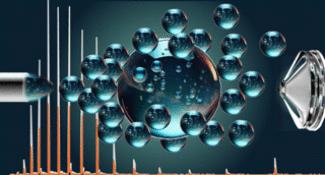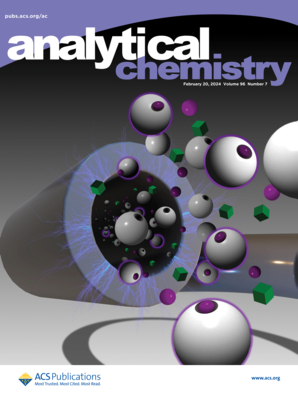Nanobubbles in Electrospray Ionization Mass Spectrometry
IF 6.7
1区 化学
Q1 CHEMISTRY, ANALYTICAL
引用次数: 0
Abstract
Nanobubbles (NBs) are very small gas-filled cavities in solvents, and when their sizes reach diameters around 200 nm, they remain in solution for extended periods of time, featuring special chemical and physical properties. Here, we investigate the application of NBs in electrospray ionization. We show that the addition of CO2 or N2 NBs into spray solvents significantly improves signal responses of small molecules in both positive and negative modes during ESI-MS. The magnitude of the increase depends on analyte identity, solvent system, NB gas composition, and the method for preparing the NBs. When NBs are used to analyze proteins, both signal intensities and charge states increase. This is tentatively attributed to NB’s increasing the total area of the hydrophobic gas–liquid interface, on which proteins can unfold, and improved transport of analytes to the droplet surface. This increase in the interface is likely also a contributing factor in the further enhancement of the rate at which reagents are converted into products when NBs are present compared to those measured from accelerated reactions from microdroplets during reactive-ESI experiments. Moreover, NBs can overcome solubility barriers when one of the reagents is gaseous and, thus, can be incorporated into an NB. This was demonstrated in the reaction between N,N-dibutyl-1,3-propane diamine and carbon dioxide, where the reaction conversion rate could be significantly improved when N2 NBs were present in solution, but even more so when the bubbles were composed of CO2.

求助全文
约1分钟内获得全文
求助全文
来源期刊

Analytical Chemistry
化学-分析化学
CiteScore
12.10
自引率
12.20%
发文量
1949
审稿时长
1.4 months
期刊介绍:
Analytical Chemistry, a peer-reviewed research journal, focuses on disseminating new and original knowledge across all branches of analytical chemistry. Fundamental articles may explore general principles of chemical measurement science and need not directly address existing or potential analytical methodology. They can be entirely theoretical or report experimental results. Contributions may cover various phases of analytical operations, including sampling, bioanalysis, electrochemistry, mass spectrometry, microscale and nanoscale systems, environmental analysis, separations, spectroscopy, chemical reactions and selectivity, instrumentation, imaging, surface analysis, and data processing. Papers discussing known analytical methods should present a significant, original application of the method, a notable improvement, or results on an important analyte.
 求助内容:
求助内容: 应助结果提醒方式:
应助结果提醒方式:


